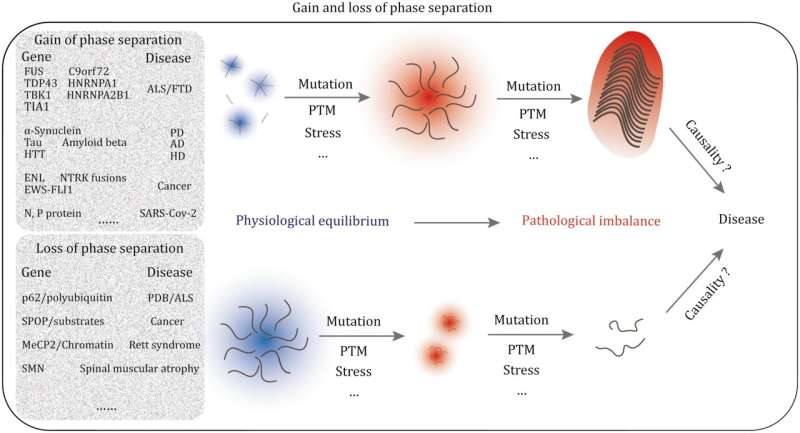This article has been reviewed according to Science X's editorial process and policies. Editors have highlighted the following attributes while ensuring the content's credibility:
fact-checked
proofread
A rethink of diseases in light of phase separation and phase transition may be necessary

A review delves into the significance of biomolecular condensation in cellular processes, the impact of aberrant phase separation on diseases such as neurodegenerative diseases, cancers, and infectious diseases, and the potential for manipulating phase separation as a therapeutic strategy.
Neurodegenerative diseases like ALS, FTD, and others impose an increasingly heavy burden on global health care systems. Within these conditions, proteins such as TDP-43, FUS, Tau, hnRNPA1, hnRNPA2B1, and polyQ-containing proteins undergo abnormal phase separation, triggering irreversible biophysical alterations. Unraveling the mechanisms behind aberrant phase separation offers a fresh perspective on understanding the onset and progression of neurodegenerative diseases.
In cancer, intricate genetic mutations disrupt normal phase separation processes, fueling tumor formation. Notable instances include fusion genes in leukemia and fusion proteins in sarcomas, precipitating significant shifts in downstream gene regulation and fostering malignant tumor growth. Targeting aberrant phase separation presents a novel avenue for comprehending and potentially treating cancer.
Pathogens exploit biomolecular condensates to bolster infectivity, while the host immune system harnesses phase separation to identify and neutralize pathogens. Viral proteins orchestrate the formation of replication centers or inclusion bodies, pivotal for viral replication and assembly, thereby amplifying viral infectivity. Understanding the dynamics of phase separation during infection sheds light on host-pathogen interactions and immune responses, potentially facilitating the development of antiviral strategies.
Present therapeutic approaches target both the "controllers" and "drivers" of liquid-liquid phase separation (LLPS). Controllers, encompassing structural proteins like enzymes, cell surface receptors, and transcription factors, undergo regulation via signaling pathways and post-translational modifications.
Meanwhile, drivers, such as specific intrinsically disordered proteins (IDPs) and nucleic acids, play pivotal roles in LLPS. Innovative drug screening platforms, like DropScan, hold promise for identifying compounds capable of modulating aberrant phase separation in diseases like cancer. Deeper insights into condensate biology are imperative for effectively manipulating transient assemblies for therapeutic purposes.
The review concludes that the field of biomolecular condensation and phase separation is rapidly evolving, providing fresh insights into disease mechanisms and potential therapeutic strategies. Ongoing research presents promising prospects for transformative therapies, reshaping our approach to disease treatment and patient care. The work entitled "Long way up: rethink diseases in light of phase separation and phase transition " was published on Protein & Cell.
More information: Mingrui Ding et al, Long way up: rethink diseases in light of phase separation and phase transition, Protein & Cell (2023). DOI: 10.1093/procel/pwad057
Provided by Higher Education Press



















